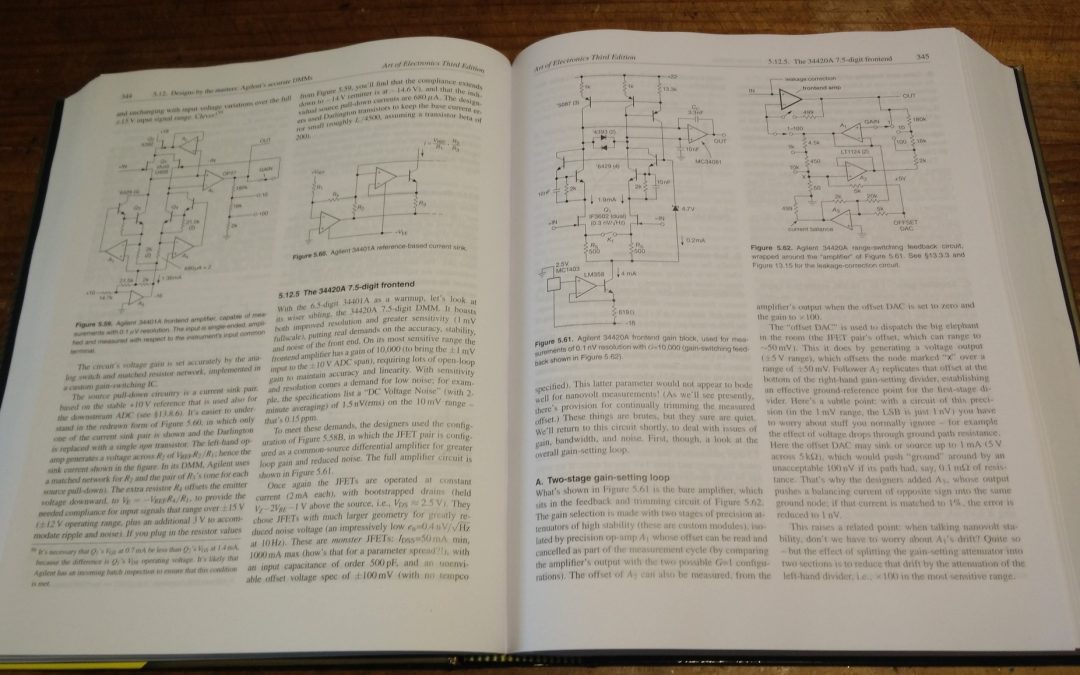I’m a little late to the party here, because it was released in 2015, but recently I received my very own copy of the third edition of Paul Horowitz and Winfield Hill’s book, The Art Of Electronics.
The Art of Electronics is one of those books you always hear about, and it’s one of those books that electronics departments keep lying around for their engineers to look at when needed. I’ve often had it available at work but have been meaning to get my own copy for the last 15 years at least. Actually I’ve got two separate employers to buy it for their team in the past, so this is the third copy I’m responsible for the purchase of.
In my experience, the strength and value of this book is not so much in teaching new information from scratch (though I have heard people also claim it taught them circuit theory basics) but in the way it organises its extremely comprehensive and practical information, and the casual yet densely packed way it delivers that information. It’s the best example of a reference book on any topic I’ve ever seen.
Usage example
Lets say you haven’t designed any precision ultra low noise analogue front end circuits for a while, but now you have a project where you need something much better than a voltage divider running a signal directly into a microcontroller ADC.
You go to the table of contents. Chapter 5 looks promising – “Precision Circuits” – The whole chapter is about 100 pages all up.
The Chapter starts off by talking about the basic areas of the requirements when looking at a precision circuit design. Then jumps into a simple example. Then examines that example, and does a post-mortem on the suitability and its shortcomings. From there, you get taken on a ride through concepts like a design’s error budget, component errors, amplifier input errors, amplifier output errors, op-amp design tradeoffs, and op-amp parameters. Then it steps you through an analysis of two very high performance analogue designs (6.5 and 7.5 digit multimeter front end) from real world products.
Then there’s chapter 8 – “Low noise techniques” – this chapter is a bit larger at about 120 pages, and much more theory heavy.
This chapter takes you through different types of circuit noise, noise measurement, the noise generated by different active components, examples and how to deal with different shortcomings of different technologies, more noise measurement, and general noise mitigation techniques.
None of this is anything that an experienced engineer will never have heard of before.. But it’s a summary of all important aspects of the job at hand. And by skimming through the book before starting a new design in an area you’re a bit rusty on, it’s just surfaced a whole field of important considerations, brought the issues that need to be solved to the front of your mind, and maybe even provided example circuits or at least design approaches that are directly relevant.
Now understand that for many other areas of basic electronic design you need to get up to speed with, there will be a similar chapter, or chapters, you can read with similar results.
Strengths and weaknesses
The book is originally written as course material for a university subject, and so doesn’t cover everything.
It covers analogue electronic components and analogue circuits extremely well. It covers power transmission and conversion. It also has introductory chapters on microcontrollers and digital logic, which I don’t find useful at all as a reference, but I’m sure they are useful in the university curriculum. It spends some time talking about standard digital serial interfaces, which might be of use for someone who doesn’t need to use something like I2C or SPI very often.
There’s basically nothing on RF electronics, and very little on high speed digital design beyond basic termination techniques. So, the book is missing pretty much anything to do with circuits where the dimensions of the circuit are in the order of magnitude of the wavelengths of signal components. This makes sense when you consider it’s still a circuit theory book that focusses on electronic components in circuits (albeit a very practically focused one) and making the step into board layout features becoming components in their own right is a pretty big step, when the book is already 1000+ densely packed pages.
Every engineer’s pocket expert?
Of course, at the end of reading 200 pages to cover over an area of expertise, you won’t be as capable as an engineer who has years experience only working in that area.. But you’ll be on the way there, and you’ll have a lot of the most important concepts fresh in mind to work with. And this is why you often see this book in the engineering departments of companies run by people who know what they are doing.

